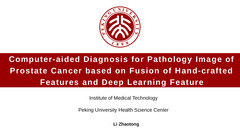Computer-aided Diagnosis for Pathology Image of Prostate Cancer based on Fusion of Hand-crafted Features and Deep Learning Feature

Start Time:2021-11-13 16:00 (Asia/Shanghai)
Duration:15min
Session:[PS1] Plenary Session 1 » [AI1] Workshop on AI
Tips: The file permissions under this presentation are only for participants. You have not logged in yet and cannot view it temporarily.
Abstract
Prostate cancer, the most common malignancy in men, has become the second largest male cancer killer in the world after lung cancer. As one of the most accurate diagnostic modes of prostate cancer examination, the performance of ultrasound-guided living tissue puncture pathological examination depends on the subjective experience of doctors, which is prone to misdiagnosis and mistreatment based on the only one pathological data. The computer-aided diagnosis (CAD), a part of routine clinical work for prostate cancer detection, further improve the efficiency of clinical diagnosis for classification of benign and malignant pathological images.
Materials and Methods:
The prostate pathological images were collected from HE (hematoxylin and eosin) slides with 40X magnification using Olympus microscopy at the Department of Pathology, Peking University Health Science Center, Beijing, China and the Department of Pathology, People Hospital of Guanzhou, Guangdong Province, China. The diagnosis of these images was made by 2 or 3 experienced pathologists based on their histologic features. Finally, 1100 effective prostate pathological images were screened to our dataset in which 546 and 554 images were classified as prostate cancer and health respectively. In addition to the methods, a novel classification model was proposed by fusing eight elaborate image features including seven hand-crafted features and one deep learning feature, which were SIFT, SURF, ORB of local features, shape and texture features of cell nucleus, HOG feature of cavity, color feature and the CNN feature of deep learning respectively. During the feature engineering phase, the BoW~TF-IDF model combined with a new data augmentation algorithm was proposed to extract the seven hand-crafted features above, and the deep feature was extracted from the convolution layers of ResNet-18. The proposed deep learning network consists of three main sections: Matching Network, Integrated Network, and Fusion Network, and the Integrated Network was again divided into Backbone and Additional Network. Specifically, the Matching Network was used to adjust dimensions of hand-crafted features to match the deep learning feature size; the Integrated Network integrated and processed these eight features in a two-dimensional space; the Fusion Network were composed by eight fully connection layers with concatenation, which realize the effective fusion of different characteristics and output the final classification results of pathology images.
Results:
The experiment results were obtained by using different backbone, ResNet-18/50, VGG-11/16, DenseNet-121/201, which showed that the proposed model with backbone ResNet-18 has the optimal performances in accuracy, specificity sensitivity and AUC, that is 95.45%, 93.64%, 97.27% and 98.34% respectively. Furthermore, we carried out a detailed analysis on the performance of the individual feature, including seven hand-crafted features and one deep learning feature, all the evaluation metrics of these individual features were lower than 90%, which demonstrated that the proposed model has an efficient performance on feature fusion of the differential extracted features. Besides, the heat map generated by the Grad-CAM++ was used to explore the difference of region of interest (ROI) between the proposed model and ResNet-18, which proved that our model focused more accurately on the cancerous cells compared with the performance of ResNet-18.
Conclusion:
A novel classification method which combined the hand-crafted features and deep learning feature was proposed for the CAD on the prostate cancer pathological image. We proved that the advancement of the proposed network from the aspect of different backbones and the individual features. The next work is to generalize the proposed method to other pathology images, e.g., breast cancer, thyroid cancer, etc. due to the identical principles of the feature engineering and deep learning.
Keywords
Speaker

兆同 李
北京大学医学部Submission Author
All comments
Countdown
-
00
Days
-
00
Hours
-
00
Minutes
-
00
Seconds
Important Dates
| Abstract submission date: |
2021-10-25 |
| Full paper submission date: |
2021-10-25 |
| Notification of acceptance date: |
2021-11-01 |
| Conference date: | 2021-11-12~2021-11-14 |
Contact Us
| Jinying Yang | +86 13675518597 |
| Debo Zhi | +86 15056085235 |
| Song Gao | +86 13121880288 |
| Le Cao | +86 15910809908 |
Comment submit